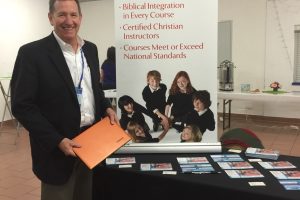
Traditional, Online, Hybrid . . . What Does It All Mean?
- Posted by Melissa Myers
- Categories Curriculum, Online Learning
- Date May 15, 2023
The pandemic brought about unique needs in education. Schools across the United States are now offering a wide variety of programs that boast individualized options, allowing students to choose between on-site or online learning experiences; move fluidly in and out of the classroom; progress at their own pace; and choose from a wide variety of remedial, advanced, or specialized courses. Of course, online education programs have offered these kinds of benefits for years. However, the demand for educational experiences that cater to individual student needs is higher than ever before, and schools are responding by offering more flexibility.
The demand for educational experiences that cater to individual student needs is higher than ever before, and schools are responding by offering more flexibility.
With the increased number of options now available to families, it can be overwhelming when choosing the most suitable solution for your child. Online programs promote the benefits of their hybrid or blended models, synchronous or asynchronous modes of delivery, or in-person or remote support systems . . . but as a parent who’s new to online learning, what do these terms even mean?
Let’s start by looking at the differences between some of the more common online education programs available today.
Traditional Programs
Traditional, “brick-and-mortar” programs take place in a school building. Classes are held in person in a physical classroom and led by an on-site teacher. Some traditional classrooms may be co-taught by two or more teachers. Many traditional programs incorporate components of online learning, where students attend classes in person and complete hands-on activities in the classroom while also completing some coursework online.
Ideal for students who:
May not be ideal for students who:
- need frequent face-to-face interactions with teachers
- thrive on in-person social interactions with peers
- prefer hands-on activities, group projects, and collaboration
- suffer from social anxiety
- struggle with bullying
- have experienced behavioral/discipline issues
- have scheduling conflicts during traditional school hours
- have specific health concerns
- do not have access to transportation and/or after-school care
Online Programs
Online programs are delivered over the Internet, typically via learning management systems such as Buzz or Canvas. Students can participate in online programs from virtually anywhere, including home, school computer labs, local libraries, or community centers.
Ideal for students who:
May not be ideal for students who:
- are self-driven and organized
- prefer to work independently
- benefit from any-time access to course materials
- must travel often
- need to be at home for health reasons
- don’t have transportation to school
- have responsibilities that prevent them from attending school physically
- need a lot of guidance and strict deadlines
- are easily distracted by other activities, such as watching TV or playing video games
- have little to no supervision at home (if completing coursework at home)
- prefer tactile (paper and pencil) work
Online courses can be delivered synchronously, asynchronously, or both.
Synchronous online courses are centered around scheduled instructional activities, such as live virtual lectures and events and real-time study sessions. They typically follow a predefined calendar—so all students begin the course at the same time and complete the course at the same time—although that is not always the case.
Ideal for students who:
May not be ideal for students who:
- require a regular routine
- need a lot of structure
- need flexibility in their schedule
Asynchronous online courses do not contain live sessions or activities. While most asynchronous courses have suggested or required deadlines to help keep students on schedule, students typically have more freedom to complete the coursework at their own pace. While live one-on-one sessions are not included in asynchronous courses, teachers for some programs may be available for one-on-one conversations upon request.
Ideal for students who:
May not be ideal for students who:
- are autonomous
- like to work independently at their own pace
- want more control over their school schedules
- are self-driven and organized
- need frequent, live interactions with teachers and peers
Bisynchronous online courses, as they are sometimes called, contain both synchronous and asynchronous components. Bisynchronous courses are typically highly asynchronous in nature but contain some synchronous components. For example, students may work at their own pace but be required to attend live class sessions, engage in one-on-one teacher meetings, or participate in group projects with peers at certain intervals throughout the course. Like their asynchronous counterparts, bisynchronous courses are ideal for students who have demonstrated autonomy and drive, while offering more opportunities for relationship-building and collaboration.
Ideal for students who:
May not be ideal for students who:
- are autonomous
- are self-driven and organized
- like to work independently at their own pace
- want some control over their school schedules
- need frequent, live interactions with teachers and peers
Another key feature of online programs relates to their enrollment terms:
- Fixed enrollment programs have predefined start and end dates.
- Rolling enrollment, on the other hand, allows students and families to choose the start and end dates that work best for them.
Hybrid Programs
By definition, hybrid programs provide on-site instruction in a traditional classroom, similar to brick-and-mortar programs, but some students attend in person while others attend virtually. In these programs, teachers stream their lectures live so remote students can experience the class at the same time as their on-site classmates. Many schools boast hybrid programs these days but true hybrid programs are becoming less common, as the definition of “hybrid learning” is shifting to align more with the blended model, described below.
Ideal for students who:
May not be ideal for students who:
- need to seamlessly move back and forth between the classroom and remote learning
- need flexibility in their schedule
With the increased number of options now available to families, it can be overwhelming when choosing the most suitable solution for your child.
Blended Programs
Blended programs combine on-site and online opportunities for all students. Students may attend classes in person on certain days of the week and complete their courses online on the other days, or they may split their days between on-site and online classes. Blended programs are becoming more and more popular post-pandemic. Again, it is important to note that many blended programs call themselves “hybrid,” so it’s important to research a program’s features to fully understand how it is structured.
Ideal for students who:
May not be ideal for students who:
- enjoy both independent and collaborative learning
- benefit from a regular routine
- enjoy frequent, live interactions with teachers and peers
- are fairly autonomous
- are self-driven and organized
- must travel often
- need to be at home for health reasons
- don’t have transportation to school
- have responsibilities that prevent them from attending school physically
- are easily distracted by other activities, such as watching TV or playing video games
- have little to no supervision at home (if completing coursework at home)
Summary
As you can see, no individual solution is best for every student. Students interact with the world around them in different ways, have unique needs, and therefore learn in a variety of ways. The key to ensuring student success is select the educational program that best accommodates each student’s diverse needs and preferences.
Tag:Parents
Melissa Myers is a dedicated educator with 20 years of experience in online course development. She holds a master's degree in educational psychology and technology from the University of Oklahoma. As the Director of Curriculum at Sevenstar, she utilizes her expertise in educational technology, instructional design, assessment design, and project management in leading the organization's course development and biblical integration efforts. Melissa is a devoted mother to her two amazing teenage sons, an active member of Victory Family Church in Norman, Oklahoma, and is actively involved in ministering to the local homeless community.



